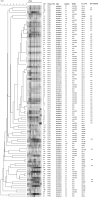Molecular epidemiology, risk factors, and outcomes of carbapenem-resistant Klebsiella pneumoniae infection in a tertiary hospital in eastern China: for a retrospective study conducted over 4 years
- PMID: 37577443
- PMCID: PMC10414989
- DOI: 10.3389/fmicb.2023.1223138
Molecular epidemiology, risk factors, and outcomes of carbapenem-resistant Klebsiella pneumoniae infection in a tertiary hospital in eastern China: for a retrospective study conducted over 4 years
Abstract
Objectives: Carbapenem-resistant Klebsiella pneumoniae (CRKP) have been extensively disseminated worldwide, resulting in increased mortality. We performed a retrospective analysis of the epidemiology and risk factors for the outcome of CRKP infection in a general teaching hospital in China.
Methods: A molecular and clinical study was conducted for 98 CRKP in a tertiary hospital from January 2013 to December 2016. Carbapenemase gene detection, pulsed-field gel electrophoresis (PFGE), and multilocus sequence typing (MLST) were performed. Logistic regression was also used to identify the risk factors associated with 30-day mortality.
Results: The production of KPC carbapenemase was the main resistant mechanism, and KPC carbapenemase increased annually with a significant difference. However, the molecular outcome revealed the dominance and diversity in CRKP with 24 sequence types (STs) and 59 PFGE types (PTs). The ST11 CRKP strains, which showed a significant increasing trend year by year, were documented as predominant in our study. Additionally, the predominant ST11 CRKP corresponding to PT10 and PT15 continued to exhibit their characteristic patterns. Importantly, the newly identified PT09 and PT16 strains, corresponding to the ST11 lineage, were only discovered in 2016. Meanwhile, factors affecting 30-day mortality and ST11 proportionality with CRKP infection were assessed, and ST11, appropriate empirical treatment, and hospital stays were found to be independently associated with 30-day mortality.
Conclusion: The ST11 CRKP strains played a dominant role in the process; however, the homology of these strains was polymorphic, and the advantage clusters were subject to changes through evolution. Furthermore, in addition to appropriate empirical treatment and hospital stays, ST11 CRKP was independently associated with 30-day mortality. To the best of our knowledge, this association was reported for the first time.
Keywords: carbapenem-resistant Klebsiella pneumoniae; epidemiology; outcomes; risk factors; sequence type 11.
Copyright © 2023 Cheng, Zhao, Ma and Li.
Conflict of interest statement
The authors declare that the research was conducted in the absence of any commercial or financial relationships that could be construed as a potential conflict of interest.
Figures

References
-
- Andrade L. N., Curiao T., Ferreira J. C., Longo J. M., Clímaco E. C., Martinez R., et al. . (2011). Dissemination of blaKPC-2 by the spread of Klebsiella pneumoniae clonal complex 258 clones (ST258, ST11, ST437) and plasmids (IncFII, IncN, IncL/M) among Enterobacteriaceae species in Brazil. Antimicrob. Agents Chemother. 55, 3579–3583. 10.1128/AAC.01783-10 - DOI - PMC - PubMed
-
- Brisse S., Fevre C., Passet V., Issenhuth-Jeanjean S., Tournebize R., Diancourt L., et al. . (2009). Virulent clones of Klebsiella pneumoniae: identification and evolutionary scenario based on genomic and phenotypic characterization. PLoS ONE 4, e4982. 10.1371/journal.pone.0004982 - DOI - PMC - PubMed
-
- Chiang T. T., Yang Y. S., Yeh K. M., Chiu S. K., Wang N. C., Lin T. Y., et al. . (2016). Quantification and comparison of virulence and characteristics of different variants of carbapenemase-producing Klebsiella pneumoniae clinical isolates from Taiwan and the United States. J. Microbiol. Immunol. Infect. 49, 83–90. 10.1016/j.jmii.2015.08.011 - DOI - PubMed
LinkOut - more resources
Full Text Sources

